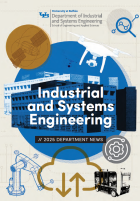research news
UB-led team awarded $750,000 NSF grant to study wildfire inequities

The Calf Canyon/Hermits Peak Fire scorched more than 341,000 acres in northern New Mexico in 2022.
By LAURIE KAISER
Published March 5, 2024
While the increasing frequency and severity of wildfires dominate headlines, the disproportionate impact upon victims is not as widely known.
To Sayanti Mukherjee, assistant professor in the Department of Industrial and Systems Engineering, the inequity between high-income individuals living in wildfire-prone areas and low-income individuals, many of whom live in rural wildfire-prone areas and are members of racial or ethnic minority groups, is an unconscionable chasm that needs to be bridged.
Mukherjee, who also directs UB’s OASIS Laboratory, was recently awarded $750,000 from the National Science Foundation’s Strengthening American Infrastructure (SAI) program to address this problem. She is principal investigator on the three-year project.
“Rural and disadvantaged communities are often the most susceptible to wildfire disasters,” Mukherjee explains, “yet they are not accounted for in the decision-making process for infrastructure protection and emergency response management.”
Co-principal investigators on the project are Susan Clark, assistant professor in the Department of Environment and Sustainability; Jose Walteros, assistant professor in the Department of Industrial and Systems Engineering; and Jungwon Yeo, associate professor in the School of Public Administration at the University of Central Florida. They will engage a team of graduate and undergraduate students from engineering, social science and public policy to work on the project.
The researchers also will collaborate with industry partners and emergency management stakeholders, including the Federal Emergency Management Agency (FEMA), the United States Department of Agriculture (USDA) and the National Renewable Energy Laboratory (NREL), and conduct in-person and virtual meetings with individuals in communities in New Mexico and Colorado recently affected by devastating wildfires.
Factors contributing to growing inequities
Two recent trends are creating a perfect storm of inequality, Mukherjee says.
First, climate change is extending the wildfire season and making the fires more dangerous. Second, rising home prices in urban areas are forcing lower-income individuals to move to less expensive areas on the outskirts of forests, which puts them closer to wildfires.
“The risk to these communities is increasing exponentially,” she says.
Mukherjee points to research conducted by Headwaters Economics revealing that nationwide, there are more than 37 million residents in counties with the highest wildfire risks. Of those, many are marginalized, including:
- 880,000 families living in poverty.
- 2.5 million people for whom English is not their first language.
- 4.4 million people living with disabilities.
- 790,000 households without a vehicle.
Disadvantaged residents left behind
“Disadvantaged residents often don’t feel like they have the power to speak up when it comes to getting critical services restored and adequate resources, including financial help, after a fire,” she says. “Typically, these communities lack the workforce, finances and expertise to access the competitive federal grants. This problem is worsened as most of these disadvantaged people do not have insurance and cannot even afford backup generators in cases of wildfire-induced power outages.”
Although the Biden administration and Congress have committed resources and financial help to rural communities following a fire, the residents often don’t know this help exists or how to access it, Mukherjee says. Meanwhile, people living in multimillion-dollar homes readily get the help and services they need, including insurance payouts.
“The higher-income groups tend to overshadow the low-income individuals and the underrepresented minorities living on the border of urban and wildland areas,” she says. “Our preliminary research shows that counties with higher Black and lower-income populations receive less personnel and funding support for recovery and reconstruction in the aftermath of wildfire disasters.”
During this project, the team will employ a four-pronged approach: assess the vulnerabilities of the interdependent critical infrastructures; evaluate the social burden of wildfire-induced service disruptions on rural and disadvantaged communities; develop efficient and equitable post-wildfire recovery strategies; and design policies for effective human-centered governance of these infrastructure systems.
“One critical challenge is understanding how essential services such as electricity, water and transportation might fail due to their strong interdependencies when facing a wildfire,” she says. “Even if a wildfire doesn’t damage a structure directly, residents may be without power due to a substation down in another community.”
Vital stakeholder input
To gain the perspective of those who have suffered through recent wildfires, the team will offer workshops, administer surveys and conduct interviews with community leaders and residents of the regions affected by the Calf Canyon/Hermits Peak Fire, which scorched more than 341,000 acres in northern New Mexico in 2022, and the Marshall Fire that blew through Boulder, Colo., in 2021.
“We’ll seek stakeholder engagement frequently over the three years of the project duration,” Mukherjee says. “It’s not just bench work, but also integrating the insights of the residents and other stakeholders to help us fine-tune our models and goals.”
By integrating social scientific theories with mathematical models, Mukherjee and her team hope to find new ways to design a framework that will improve the emergency management of critical infrastructure systems and connect needier residents with help, both before and after a wildfire incident.
“We aim to improve the resilience of the communities through strengthening the emergency management system to help the communities better prepare while helping emergency managers, utilities and other governmental and non-governmental agencies to respond more efficiently,” she says. “Finally, we want to create a long-term, equitable, disaster management plan that will serve the needs of the most vulnerable residents.”

